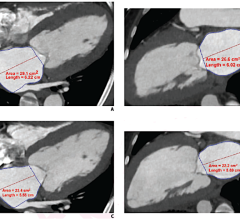July 24, 2012 — The importance of utilizing computed tomography (CT) in pre-planning for transcatheter aortic valve implementation (TAVI) and the benefits from viewing CT images via the Philips IntelliSpace Portal was highlighted at the 7th Annual Society of Cardiovascular Computed Tomography (SCCT) Scientific Meeting, July 19-22 in Baltimore, Md.
TAVI, performed under fluoroscopic and echocardiographic guidance, is a valve replacement procedure that reduces mortality by 61 percent for patients with severe aortic stenosis who are not candidates for surgery.
The Philips IntelliSpace Portal has numerous applications useful for pre-planning TAVI procedures:
- The Cardiac Viewer aids in performing general viewing operations;
- Advanced Vessel Analysis (AVA) enables analysis of the TAVI catheter access route to reduce risk of vascular injury;
- Comprehensive Cardiac Analysis determines angles for visualization during deployment in the cath lab; and
- Heartbeat CS assesses the amount and distribution of calcium in the valve.
Additionally, using CT to help guide appropriate C-arm angles for initial X-ray positioning can save time and assist with proper dose management.
“TAVI is a minimally invasive way to reach a previously untreatable cardio patient population. As TAVI is increasingly adopted in the United States, a pre-planning CT can prove extremely beneficial,” said Pál Maurovich-Horvat, M.D., Ph.D., Semmelweis University Heart Center in Budapest, Hungary. “The Philips IntelliSpace Portal allows flexible access points in the convenience of my preferred workspace — whether it’s the office desktop, the PACS (picture archiving and communications system) workspace, laptop or portable device.”
TAVI has been widely performed in Europe since 2007 and is no longer viewed as experimental. Transcatheter aortic valve replacement (TAVR) devices gained U.S. Food and Drug Administration (FDA) approval in late 2011.
For more information: www.philips.com/IntelliSpacePortal


 February 01, 2024
February 01, 2024 








